HMAS Creswell and the RAN College, heritage jewel in the defence crown
by Tom Lewis
For 90 years the Royal Australian Naval College (RANC) has educated the RAN’s naval officers. In that time, it has built up a unique and precious collection of artefacts to complement the beautiful buildings set alongside Jervis Bay’s pristine waters.
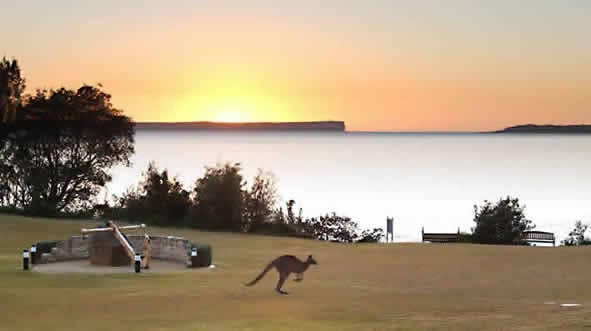
Sunrise at Creswell, over Memorial Park.
The College, first established in 1913, was originally located at Osborne House in Geelong, Victoria, for two years, while the Jervis Bay site was being readied. The present golf course within RANC was the “tent city” of the hundreds of workmen who laboured for five years to produce the stone and weatherboard buildings that still are used for naval training today. The “Class of 1913” arrived at Jervis Bay in 1915, and graduated at the end of 1916, joining ships then engaged in World War One. Among the first class were John Collins and Harold Farncomb, who would achieve Flag rank in WWII, and command over British and American ships, thus signifying the success of the RAN College experiment.
The geographical pattern set from 1913 reflects the “garden city” concept used to design Canberra. A main ridge was levelled to form the “Quarterdeck”, and the buildings of the College were grouped around that. Accommodation for both staff and cadets was at a distance. With the removal of the seamen’s quarters (where the present gymnasium stands), a College accommodation building and a stewards’ block, the rest of the original buildings remain today, with some additions to the design of timber and stone, unfluted Doric columns and tiled roofs.
College relocation
The Great Depression’s effects struck hard at RANC in 1930, seeing the College, in a cost-cutting exercise, moved to the sailor-training establishment of HMAS Cerberus near Melbourne. Many of the Jervis Bay buildings were then leased to hotel proprietors, heralding a new existence for the site. This meant that many holiday-makers were able to enjoy the white sand beaches and clear waters of the Bay from these new holiday resorts. The choices ranged from the Commanding Officer’s House, renamed Canberra House, at four pounds a week, and moved through a range of alternatives, down to the cheapest accommodation of Links House, formerly the sailors’ quarters.
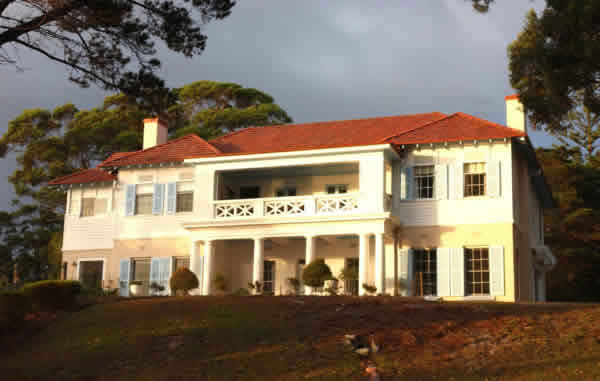
Historic buildings in Creswell include the Captain’s house (above) and the old Naval Lodge Hotel, now Senior Sailors Mess (below).
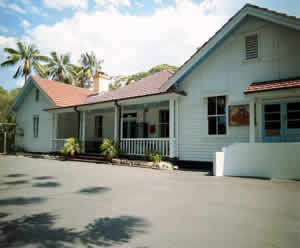
It was not until 1958 that the College was moved back to the Bay, when it became part of a newly-commissioned establishment, named HMAS Creswell, after the “father of the Navy”, VADM William Creswell, who argued strongly for the establishment of the RAN after Federation. The buildings suffered somewhat however, with a few having to be removed upon the Navy’s return, due to poor maintenance. Most of the remaining buildings have changed their purposes over time.
College dining room
Perhaps one of the most beautiful of the constructions that retain their original purpose is the College Dining Room. This has been located on its present site since its construction in 1914. In the hotel period it was used as a cinema. The building is distinguished by the thrust beams above the diners’ heads, and by the tall walls lined with honour boards. The Dining Room and its Galley were substantially renovated in 1999. One of the unique aspects of the College in its original location is that trainees walk the same grounds and are trained in the same buildings as previous generations of successful naval officers.
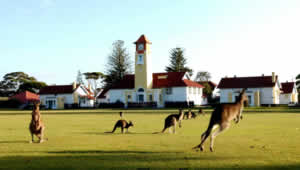
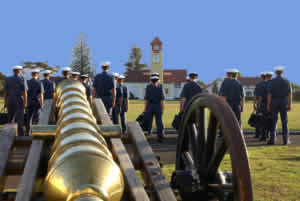
Kangaroos on the quarterdeck (left) and Midshipmen fall in near the brass cannon (right).
The brass cannon from the 1900 Boxer Rebellion has been in front of the Dining Room for many years after having been brought back to Australia by the naval contingent. The rangefinder from the first HMAS Sydney also has been positioned in the front of the building for many years. It was first featured in a 1923 College Magazine. The explanatory plate notes that it was presented to the College by CAPT Glossop, commander of HMAS Sydney in that ship’s victorious action against the German cruiser Emden. The bell tower’s building date is not known, but the bell dates from the 1958 return to Jervis Bay when the name HMAS Creswell was chosen for the Establishment’s commissioning.
Set at a distance behind the wardroom are a number of houses. Eleven remain, the others having been gradually replaced over the years by more modern designs. The houses, which have a history of occupation by officers living on the base, have some similarity in design and were built in two periods: 1913-15, and 1920. They follow the same design of gabled roofs over 3.5 metre ceilings, open verandahs and a multiplicity of bedrooms. Most have five, which can be used for this purpose or as studies, playrooms etc. The interiors all had polished board floors originally but these have now been largely replaced by carpet. In the kitchens a large fireplace that once housed a wood-burning stove is now often a cupboard. The gardens of many of these houses merge into the surrounding parkland.
Captain’s residence
The Captain’s residence was originally built in 1914. Its isolation reflects the position of a captain apart from the ship’s officers on board a warship. For many years a tall radio mast stood nearby. During the Hotel Period it was featured in advertisements as having: “Every convenience including Hot and Cold Running Water, Electric Light and Sewerage”, at a rate of four pounds and four shillings per week.
During that time an annex to the building was built. In 1920 a servants’ wing was added and the south-west balcony enclosed. In 1958 a new bathroom was added to the first floor, and in 1960 some additions from the Hotel Period — paths, ponds and pergolas — were removed. The name was changed back to the “Captain’s residence” in 1958.
Another building of interest within Creswell has seen substantial change. What is now the Senior and Junior Sailors Messes was originally the Establishment Hospital. An isolation ward was located at the northern end and an operating theatre inside the main building. It is a sign of the times in which the College was built that such a large establishment was needed: many people were often sick, and death was not as unfamiliar as it is now. A Cadet Otto Albert, for example, died in 1915 from influenza.
During the Hotel Period the Mess was renamed the Naval Lodge Hotel (the front doors still bear the initials NLH) and managed by a Mr and Mrs Maffesoni. According to a WAAF Officer stationed at Jervis Bay during the war, the Lodge was an “upmarket rendezvous for holidaymakers from Sydney”.
Many alterations have been made to this building. Upon the Navy’s return to Jervis Bay in 1958 some accommodation outbuildings were found to be in an abysmal state and demolished. The original purpose of the hospital building was unsuitable: such a large building was no longer needed due to advances in medical practice. A change of identity was made, adding a central bar that serves both messes, redesigning rooms as dining and recreation rooms and so on. The whole complex now is large and quite complicated in layout.
Historical collection
The College’s Historical Collection houses many hundreds of items of heritage significance, including books dating back to the arrival of the first settlers in Australia, items relating to RN history, and of course memorabilia associated with College graduates. This latter category includes items such as John Collins’ uniforms, swords belonging to Rankin and Farncomb and one commemorating HMAS Sydney II. There are also some 15,000 photographs detailing RAN and College history going back to 1911 and a large number of naval artefacts, some of them going back centuries.
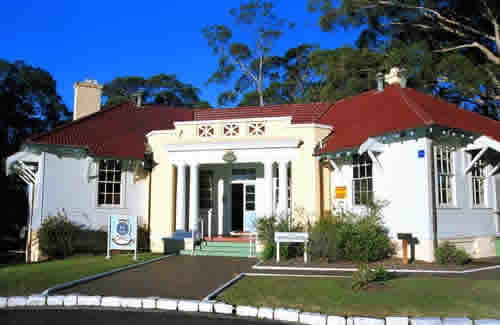
The RANC’s Historical Collection house.
These include the Hunter telescope. Hunter arrived with the First Fleet in the rather unusual position as second captain of HMS Sirius and made surveys of Sydney Harbour and Botany Bay. He was the second governor of NSW, from 1795 until 1800. His telescope is a leather-bound brass instrument, in fair condition.
A silver tureen presented to the College in 1966 by a descendent of Captain Dawson RN, stands around 30 cm in height. It carries the hallmarks of the City of London in the year 1810. The lid is surmounted by the Dawson family crest, a lion’s head with a rat in its mouth. The tureen is accompanied by a ladle marked 1777. These pieces of silver are internationally famous. They are featured in Roger Perkins’ Military and naval silver: treasures of the Mess and Wardroom, published in 1999.
The collection includes a Nelson signature made with the Admiral’s left hand. He lost his right arm after the battle of Santa Cruz in Tenerife when he was hit by grapeshot. On the way back to his ship, at that time the Theseus, Nelson lay in the bottom of the boat with a tourniquet around his arm, half conscious from loss of blood. When they reached the ship, he was half-hauled on board, clinging to a rope with one arm while he climbed up the ship’s side. Once on board he gave orders for the surgeon to be called immediately, saying: “for I know I must lose my arm, and the sooner it is off the better.”
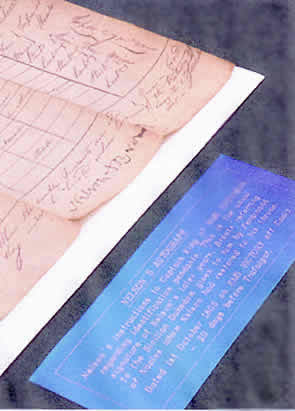
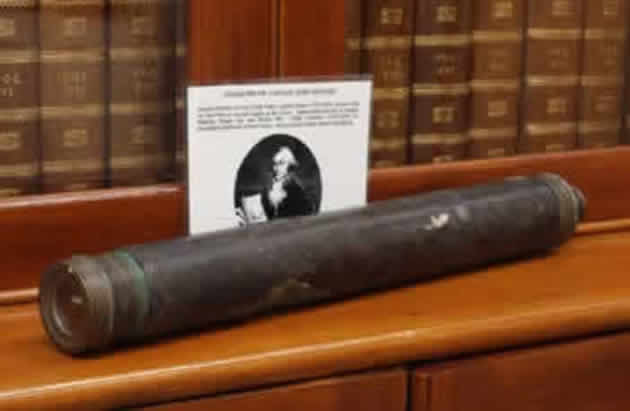
Artefacts in the museum include Nelson’s signature (left) and Governor Hunter’s telescope.
The full signature is “Nelson Bronte”, which reflects Nelson’s award of the Dukedom of Bronte in Sicily from King Ferdinand in 1799. The document gives Nelson’s instructions to Captain King regarding the use of signal pendants, and is dated 1 October 1805, 20 days before the Battle of Trafalgar.
There is also a collection of presentation swords given to officers for special gallantry Usually presented by a patriotic organisation, this custom saw its peak during the Napoleonic wars between Britain and France.
In the days when swords were employed as weapons, an officer often would own two, one a fighting item and the other for ceremonial occasions. Fighting swords were based on the sabre, with an edge and a point, and were often taken into battle without the scabbard, as it might trip up the wearer in the melee that usually ensued whenever an enemy ship was boarded. Sailors carried cutlasses, plain and functional heavy-edged weapons that were usually taken up from cases on the deck.
Presentation swords were a badge of honour: sometimes a senior officer gave a junior officer such as sword, as did Captain Duncan in 1810 when he presented a sword to his Lieutenant, Watkin Pell. Sometimes, and unusually, a ship’s crew gave an officer a sword. The Petty Officers and ship’s company of the bomb vessel Infernal presented one to Lieutenant James Legard in 1830, to honour his leadership in a particularly trying disciplinary period.
Most common of the presentation swords however, were those awarded by the Patriotic Funds, such as one sponsored by Lloyd’s. The sword was “of fifty guineas” or an alternative value, depending on the significance and/or gallantry displayed during the action.
The blade was usually inscribed, as these are, with an account of the action, the name of the recipient and the name of the Fund. Two swords commemorate the same action, in 1808, of LEUT William Dawson RN, who took command of the 36-gun frigate HMS St Fiorenzo after the death in action of his captain, Hardinge. The ship was fighting the 56-gun French frigate La Piedmontaise, which had attacked a British convoy.
The French ship was captured, and two swords were duly presented: one by the association of the ship owners, and the other by Lloyd’s Patriotic Fund.

Interesting, I have known for years my great uncle, Joseph Maffesoni and his wife managed a hotel down in Jervis Bay somewhere but when asking locals, they had no idea. I now can see it was actually at Creswell. I have I think a napkin from the period with the name on it. Maybe my grandfather, Joseph’s brother visited there in those early years.